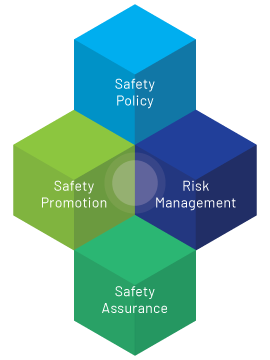What Is Data Mining in Aviation SMS?

Data mining is a critical, intermittent risk management activity safety managers need to perform in their aviation safety management systems (SMS) to organize, understand, and process collected safety data acquired during the organization risk management processes.
Data mining techniques can be performed with a modest, home-grown aviation safety database and simple tools or with complex software and professional, commercially available aviation safety databases.
Data mining goals are to establish:
- Trends in safety data and occurrences that are hidden in vast amounts of disparate data;
- Validity of identified trends to predict whether risk controls successfully anticipate expected future events;
- Correlations between different safety elements;
- Identify patterns in both employee and managerial behaviors; and
- Extract important safety knowledge from acquired safety documentation to facilitate data-based decision-making processes.
Related Predictive Risk Management Articles
- Difference Between Reactive, Predictive and Proactive Risk Management in Aviation SMS
- Going From Reactive to Predictive Risk Management in Aviation SMS
- How to Do Predictive Risk Management Data Mining in Aviation SMS
Including Accountable Executive in Data Mining Process
Successful data mining activities in aviation SMS implementations allow you to:
- Monitor organization's safety performance;
- Anticipate expected safety events;
- Describe your system in greater detail for safety risk management (SRM) analysis; and
- More complete understanding of dynamics affecting safety performance.
In aviation SMS implementations, data mining is the responsibility of safety managers and supporting safety teams. However, since accountable executives are responsible for ensuring the aviation SMS is properly implemented and performing in all areas of the organization, the account executive will need to provide oversight into the data mining process.
Too often, accountable executives are not included before safety teams initiate their data mining activities. This unintentional failure affects the ability of the accountable executive to provide oversight for the system that is directly under their control. Every accountable executive must regularly review their organization's safety performance and whenever substandard safety performance is identified, the accountable executive is responsible for correcting the substandard safety performance.
In addition to providing oversight for the aviation SMS, accountable executives are familiar with organizational goals and objectives that may be affected by any insights offered by the aviation SMS data mining activities. These two reasons should be enough to convince any safety team of the importance of including the accountable executive in the data mining processes. In short, the accountable executive is responsible for monitoring organizational safety performance and may provide insights that extend beyond the purview of safety managers.
What Is Required to Practice Data Mining

To practice data mining, you obviously need to have some data to mine. This data may come from:
- SMS databases;
- Operational databases;
- Spreadsheets;
- Statistics published by regulatory agencies and standards bodies, such as ICAO, IS-BAO, IATA; and
- Other similar types of service providers sharing safety information.
A great deal of data will be collected naturally as a result of documenting the SMS' risk management processes, assuming that your SMS implementation is actively collecting safety data in the operational environment.
Active is the "all word" for a risk management program. It simply means:
- Safety issues are being regularly reported by employees and other stakeholders;
- Safety issues are timely processed using the organization's documented risk management processes;
- Changes are being implemented, documented and monitored; and
- Safety information resulting from risk management processes are regularly documented; and
- Stored safety information is able to be easily retrieved and analyzed for "anomalies."
Related Aviation Safety Database Articles
- What Is an Aviation Safety Database for SMS Implementations?
- Pros and Cons of In-House SMS Database and Off-the-Shelf-Solutions (COTS)
- When to Design Your Own Aviation SMS Database
Core Aviation SMS Activities Facilitate Data Mining
In every organization, several core activities drive the engine of every SMS implementation. These activities include:
- Hazard identification;
- Reporting safety concerns;
- Tracking audit findings; and
- Risk management processes that validate safety risk controls and align operational processes with the system design (safety risk management component).
Assuming these activities are happening frequently enough, you can begin to “make sense” of your data by exploring what you have documented. Which begs the question, what is important to document?
The word we are looking for is called “metadata,” which is information that describes the data and gives it context. For example, some important pieces of metadata that are needed to do sufficient data mining are:
- Classifications, such as type of issues, hazards, human factors, root causes, policies/procedures, etc.;
- Dates and times of issue reporting and risk management operations; and
- Persons involved, affected organizational departments, and locations of data.
How Does Data Mining Work?

Numerous data mining techniques can be used to fulfill the following goals in risk management programs:
- Relational trends;
- Correlating safety factors;
- Clustering data, which helps identify 2 or more correlating factors;
- Sequential patterns, which identify regular occurrences of similar events over long periods of time (i.e., bird strikes in different seasons); and
- Predictions of safety outcomes.
These goals can be accomplished with several data mining methods:
- Cluster analysis;
- Histograms;
- Nearest Neighbor;
- Decision trees;
- Pie charts; and
- Line charts.
There are numerous other methods for data mining, but usually the above methods will be used in most instances. These methods will allow you to establish patterns, trends, and hard-to-define relationships.
Related Aviation SMS Trend Analysis Articles
- Six Steps How to Perform Trend Analysis in Aviation SMS
- How to Prepare Data for Trend Analysis in Aviation SMS
- Aviation Safety Managers' Best Friend - Trending Charts
Why Data Mining Is So Important to Aviation SMS Implementations
Data mining in aviation SMS implementations is incredibly important for several prime reasons:
- Develop and monitor important safety goals and objectives;
- Validate whether safety goals and objectives are being reached;
- Develop key performance indicators (KPIs) to monitor safety goals;
- Develop leading indicators;
- Identify and incorporate additional data sources into safety performance monitoring activities; and
- Provides opportunities for safety teams to simplify overly complicated data structures.
Safety goals and objectives demonstrate safety performance monitoring activities within the aviation SMS, and data mining is how you evaluate whether those goals are being reached. If you have not yet identified your safety goals and objectives, this article should motivate you to consider the data mining processes necessary to acquire data to validate whether safety goals are being accomplished. These data mining processes include:
- Integrating data from various data sources;
- Cleaning data to remove duplicates or errant records;
- Transforming the data into spreadsheets or database tables for further analysis;
- Evaluating transformed data for trends or patterns; and
- Preparing data for managerial presentations (PowerPoints, charts, graphs, etc.).
Data Mining Critical for Continuous Improvement
In addition to being able to develop and evaluate safety goals and objectives, data mining is also how you demonstrate the continuous improvement of the aviation SMS. Continuous improvement is the cycle of:
- Evaluation of program;
- Development of changes; and
- Implementation of changes.
Development and implementation hinge on proper evaluation of safety performance. Data mining is almost undoubtedly the single most important determinant in how well you evaluate the aviation SMS' performance.
Related Aviation Safety Performance Monitoring Articles
- How to Conduct Safety Performance Monitoring and Measurement
- 10 Great Reports to Monitor Safety Performance in SMS - With Examples
- How to Monitor Aviation SMS Performance Using Safety Charts
Final Thoughts on Data Mining in Aviation SMS Scenarios
For decades, we have heard the saying: "Garbage in, garbage out." This saying highlights the importance of using quality datasets to arrive at fact-based and data-based assumptions. If your datasets are incomplete or hold incorrect records due to data entry errors, your assumptions may be incorrect.
If you are like many other aviation service providers, you may base your aviation SMS data management strategy on spreadsheets, email, and paper. Unfortunately, these are among the most difficult data types to mine for information. In the perfect world, every operator would have a robust aviation SMS database that:
- Collects safety reports and audit findings (inputs);
- Documents risk management activities performed on safety inputs;
- Integrates with hazard and risk register for optimal risk management review processes;
- Tracks investigations and completion of corrective and preventive actions;
- Delivers and monitors safety promotion activities; and
- Generates various reports based on the risk management phase (reactive, proactive, predictive).
A frustrating experience shared by most safety managers is when the accountable executive asks for safety performance reports and the safety manager does not know where to get the data necessary to generate the reports. This issue becomes more prominent when the data is not centrally located but resides on various users' computers or in ill-defined network drives.
To avoid common data mining woes, I recommend that your SMS data management strategy employs a low-cost, commercially available SMS database. Commercially available SMS databases have been designed to address specific SMS requirements across the entire SMS implementation.
To learn how your organization can benefit from a commercially available SMS database, watch these short demo videos.
Last updated in April 2025.







